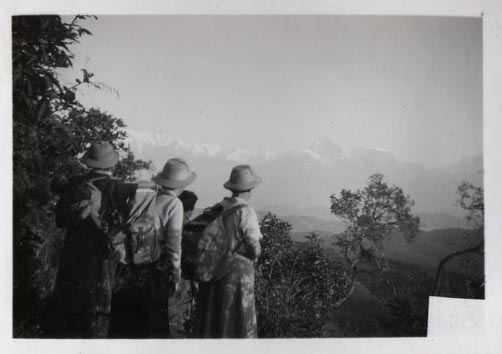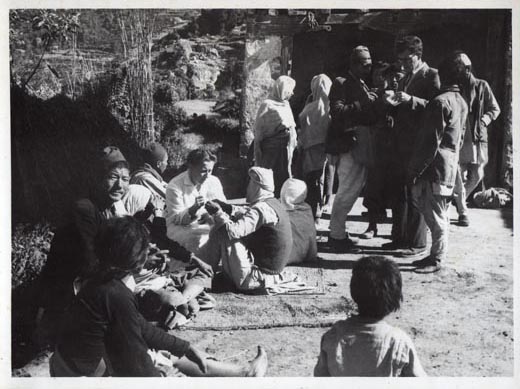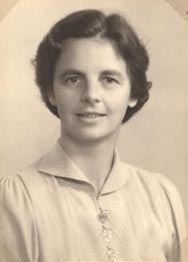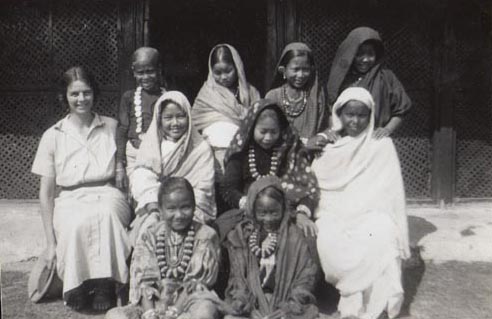Christianity in Nepal: Documentation from the Day Missions Collection
|
|
Nepal is located in the Himalayas, bordered to the north by China, and to the south, east, and west by India. It has a population of nearly 30 million and is one of the world's poorest nations. Until Nepal became a republic in May 2008, it had been ruled by monarchs or a ruling family for most of its history. Until the early 1950s Nepal was a closed country into which foreigners and Christian missionaries were not permitted. |
|
|
When Nepal cautiously began to welcome the outside world in 1951, there were a few Christians in the border areas. Ethnic Nepali Christians in Darjeeling, India, on Nepal's eastern border, and many Western missionaries along the southern border had prayed for years for the opening of Nepal to the gospel. A few South Indian Christian technicians, working in Indian aid projects, started a congregation in Kathmandu. Soon Nepali-speaking Christians from Darjeeling arrived, and the church was planted. Church growth was slow due to the hostile cultural and political environment. Until November 1990, changing religion was illegal. The law authorized severe penalties for attempting to convert another person. Christians were jailed for voluntarily changing their religion and for engaging in normal church activities. |
|
From National Council of Churches of Nepal website (http://nccnepal.org ): Christianity and Nepal With the political change in 1951 Nepal opened its doors to the outside world and Christianity entered into Nepal. International Christian mission organizations started coming to Nepal. They were not allowed by the government to engage themselves in religious activities but were asked to help in the development process of the country. Though the witness and contribution of individual missionaries and the prayer of Christians worldwide definitely contributed to the promotion of Christianity in Nepal, outside missions were not able to play a direct role in the growth of the Church and Christianity in Nepal . As there were no opportunities for higher education in Nepal, many young people went abroad for higher education. While abroad, some of them came into contact with Christianity and embraced Christianity. They came back to Nepal, shared their faith with their family members and others and established Churches. Another way in which Nepalese came into contact with Christianity was through military service in British and Indian army. The Church in Nepal is said to be one of the fasted growing Church in the world with an estimated number of 800,000 today. One factor which contributed to the rapid growth of Christianity in Nepal is through healing by prayer. Caste system in Hinduism and the Hindu domination experienced by indigenous and ethnic communities for centuries has attracted many people to Christianity. The Church started growing rapidly, specially, after the political change of 1990. |
The United Mission to Nepal The United Mission to Nepal was formed in 1954 in response to an unexpected invitation from the government of Nepal to establish a hospital in the chief western town of Tansen and to begin clinics in the Kathmandu Valley. Eight mission agencies working in India came together to form the United Mission to Nepal as an international, interdenominational mission on March 5, 1954. Over the years the number of member bodies of UMN increased to 39 agencies from 16 countries. The work expanded from health services to education, industrial development and rural development.
From the beginning, missionaries assigned to the United Mission to Nepal knew that the basis for their visas was their technical and professional expertise and that there were restrictions on overt Christian witness. Yet they came convinced that through their work and relationships the kingdom of God would be expanded and the gospel shared by “word and life.” |
|
|
Programs of the United Mission to Nepal The first maternity clinic had already opened in Bhaktapur on 7 January 1954 and the first UMN hospital was opened in Kathmandu a month later, housed in the government Cholera Hospital. In September 1954, medical work began in Tansen in a rented house in the bazaar. Soon plans were made for building a larger Tansen Hospital, and work expanded to include community health, agriculture, and other activities.
Education activities were quickly added to UMN's work. From 1957 schools were opened in Amppipal and later in Luitel. A dispensary was set up, which later became Amppipal Hospital. Agricultural and animal health work was also initiated - the first seeds of UMN's involvement in rural development. Meanwhile, in Kathmandu, UMN opened the Mahendra Bhawan Girls' School. This was the country's first girls' high school, and it soon gained a reputation for its academic excellence. |
| In Tansen, the building of the new hospital made progress, but the pace was slow because of the difficulty in finding skilled workers. Odd Hoftun, who led the construction work, had a vision for educating young Nepalis in technical skills and utilising the hydropower potential of Nepal's rivers to create opportunities for small businesses. He managed to raise support from his home country, and brought 176 tons of equipment from Norway to Butwal in 1964. This was the beginning of UMN's Engineering and Industrial Development work. Tinau Hydropower plant was built and the Butwal Technical Institute established. In 1966, Butwal Power Company was formed, the first of a series of companies founded by UMN. |
 |
 |
In 1959, the Headquarters was established in its current location in Thapathali, Kathmandu. Work expanded quickly in terms of both personnel and activities. Okhaldhunga (initially a dispensary) was added to the UMN hospitals in the early 1960s. The hospitals reached out to the surrounding communities through Community Health programmes, providing primary care in health posts, but also seeking to promote good health practices and prevent illnesses through awareness raising and development activities. Training of health workers was a part of UMN's work from the very beginning. This was first institutionalized in 1959 through the establishment of the School of Nursing at Shanta Bhawan Hospital, known today as Lalitpur Nursing Campus. |
A major new venture in the education sector was the establishment of Gandaki Boarding School (GBS) in Pokhara in 1966. GBS earned a reputation throughout Nepal for its high standards, and many GBS graduates today hold positions in government and civil society. Provision of scholarships, UMN ensured that talented boys and girls from disadvantaged and poor communities also had access to quality education through GBS. In 2000, tertiary education was added through the establishment of the Gandaki College of Engineering Science. |
|
|
The early 80s saw a new wave of enthusiasm and initiative in UMN, including a growing interest in rural development. The Rural Development Centre was established in Pokhara in 1981. This centre provided consultancy and training in animal health and husbandry, and gradually added horticulture, forestry, drinking water systems, organizational development, and training of trainers. The hydropower project in Andhikhola, begun in 1982, was complemented by a significant element of community empowerment and development, and a new project was set up in Surkhet in the same year with the aim of meeting the needs of the local communities. In the past ten to fifteen years, specialized health programmes have evolved, focusing on particular areas of health needs in Nepal. These were Mental Health, Nutrition, Oral Health, Rehabilitation of the Disabled, Tuberculosis, Reproductive Health and HIV/AIDS. They have made significant contributions in research, training, health education and development of appropriate services, and have increasingly had an impact on government planning and policy development.
|
|
In the industrial sector, UMN has continued to build the capacity of the companies it started in the 60s and 70s, while handing over ownership and management. Several of these companies are today market leaders in their respective fields. In recent years, the focus has shifted back to the development and support of small-scale enterprises. The Enterprise Support Programme began in 2000, building on experiences from enterprise development in Andhikhola and on the technology development work of Development and Consulting Services. Kathmandu University has become an important partner for UMN's strategy of skills development. |
UMN's emphasis has shifted from input of external resources to facilitating access to and use of community resources. More weight has been given to community ownership of the development activities. This has resulted in empowered communities continuing development work themselves when UMN projects have been phased out. The divestment of directly implemented programmes, projects and institutions started in early 2003 as per UMN's new strategic directions and several of them were handed over Nepali organisations in orderly manner by July 2005. UMN continues focusing on decentralization and capacity building Nepali organisations and handover of remaining programmes. |
|
The Okhaldhunga Project of UMN In May 1961 permission was received from His Majesty's Government of Nepal to open a dispensary in Okhaldhunga, East No. 3 District. In November of the same year Dr. James Dick, Jill Cook, and Mariam Sharpani reached Okhaldhunga and began living in the bazaar where they opened a dispensary. In early 1962 they moved out of town into rented houses in a Rai village about 20 minutes away. At the end of 1962 they bought land in this village and began to build a set of 6 buildings for the permanent work of the dispensary and the residence of the staff.
“The usual way to travel to Okhaldhunga in 1962 was to ride a car out of Kathmandu eastward as far as Banipa and from there take to the foot-road. For several hours the road is high on a ridge with open views northward to the snows. Hill people are coming and going with their loads and goods.” |
“Meet the Project Team. Dr. and Mrs. Dick with two of their children (the third is asleep); Mariam and Hastaman Rai; and Jill Cook.”
“Here we are, walking into the yard of the Dick's rented home, an ordinary farm home in the Rai village. They have been well received among these close neighbors and the children know more Nepali than Scots.” |
“Early in the morning the patients and their friends are waiting in the yard for care. In this beginning stage the work is done in a rented village house not at all suitable for the job, but usable. Jimmy Dick and Jill Cook do what they can out in the warm sun before taking patients in for treatment.”
“The Okhaldhunga Dispensary and residences, as completed in the late 1960s” |
"The Okhaldunga Hospital is located in a montainous rural area. Shown here are two men carrying a new ultrasound machine up to the hospital."
“Hannah Vitzthum and assistant treating an old lady in her home/shop” |
International Nepal Fellowship International Nepal Fellowship, Worldwide is an international non-government organization. Though its official registered head office is in Australia, its International Service Office is in Nepal's capital Kathmandu and it works in Nepal through five-yearly agreements with the Nepali government's Social Welfare Council. INF Worldwide finds, trains and supports expatriate volunteers to work with INF Nepal and other partner organizations, including Nepali government health and training institutions and community-based organizations. INF has six offices across the globe, two in Nepal, and one in New Zealand, Australia, North America and the UK. |
"Closing meeting of a Bible Rally in Nautanwa. Lily gives the prizes" |
INF was born in 1936 when its founding missionary Dr Lily O'Hanlon felt called to Nepal. Dr. O'Hanlon and Hilda Steele traveled to India where they worked with Indians and Nepalis on the border of Nepal until they were able to register as the “Nepal Evangelistic Band”' in Lucknow on the 22nd February 1943.
By 1950 the Band was a team of ten expatriates and nineteen Nepali volunteers. Along with Dr. Ruth Watson, known as “Kanchhi Doctor”, three nursing sisters and a team of Nepali colleagues, they trekked to Pokhara in November 1952, establishing a general hospital, the Shining Hospital, in April 1953.
Dr Lily O'Hanlon |
In 1957 the mission opened Green Pastures Hospital for leprosy patients. In the 1960s the mission expanded its work into remoter areas opening village clinics in Baglung, Sikha and Beni. From the 1970s the government of Nepal's 5th 5-year plan included significant health proposals, and INF began developing working relationships and co-operative projects with the government, including the building, equipping and staffing of Gandaki Zonal Hospital, which later became the Western Regional Hospital, the main hospital in Pokhara. The mission also signed an agreement with the government for a major leprosy control project in West and Mid-West Nepal, and was working in the areas of Tuberculosis control and community health.
In the 1990s the mission began working in the areas of drug and alcohol abuse and AIDS prevention. The mission has also been involved in education and training programmes for staff employed by the government and NGOs, and for its own staff and their children. |
On top: founder Dr. Lily O'Hanlon with a group of village girls Above: First day at Pokhara Hospital
|
|
Outside the women's ward of Pokhara Hospital |
Nepal Church The roots of the Nepali Church can be traced back to 19th century Scottish and Scandinavian missionaries working among Nepali migrants in North-East India. As in the 1950s Darjeeling was the base from which Nepali evangelists returned to Nepal, in 1998 it was the venue of the Himalayan Congress of Evangelism (HIM-COE) that gathered Nepali Christian leaders dispersed around the world. Nepali Church evangelism is today concerned to spread the Gospel among Nepalis at home and throughout the Nepali diaspora.
In1951 the Kingdom of Nepal opened its frontiers to the external world. Christians, for the first time in two hundred years, were allowed to settle in the country. Church growth was initially slow, and Christians were vulnerable to social and legal persecution. From a few hundred Nepali Christians in the 1950s and 1960s, their number is now in excess of 300,000. This represents one of the fastest rates of church growth in Asia. |
|
 |
The Nepal Church History Project was an initiative of local church leaders in Nepal to research and collect materials relevant to the history of Christianity among the Nepali peoples. It began in 1985 and continues under the chairmanship of Dr Rajendra Rongong of Kathmandu. The objective of the Project is to preserve, maintain and update a comprehensive, organized documentary record of the Nepali Church from its inception, and to make available documents and information as appropriate to researchers, students and other interested users. |
For more photos, see also the AdHoc Image and Text on the History of Christianity Database.
YDSL Special Collections Finding Aids for Nepal Organizations' Records:
- United Mission to Nepal Archives, Record Group No. 212
- Guide to the International Nepal Fellowship Archives, Record Group No. 214
- Nepal Church History Project Archives, Record Group No. 215
Books displayed in the exhibition at the Divinity School Library:
- Mary Cundy, Better than the witch doctor, Crowborough : Monarch, 1994.
-Alice Cobb, Come to Shanta Bhawan !, New York : Friendship Press, c1963.
- Dorothea Friederici, Namaste Nepal: 20 Briefe an Manuela, Erlangen : Verlag der Ev.-Luth. Mission, 1982.
- From His hand to ours : being an account of the work of the N.E.B. until 1959, Perth : Milne, Tannahill & Methven, 1959.
- Thomas Hale, On the far side of Liglig Mountain : the adventures of an American family in Nepal, Grand Rapids, Mich. : Zondervan Pub. House, c1989.
- Thomas Hale, Don't let the goats eat the loquat trees : adventures of an American surgeon in Nepal, Grand Rapids, Mich. : Zondervan, c1986.
- Peter Emmerich Hansen, Nepal - et land pa vej ?, Kobenhavn : Dansk Santalmission, 1987.
- Patricia Hepworth, Fires at the foot of Fish-Tail, Edinburgh : Nepal Evangelistic Band, 1959.
- Jonathan Lindell, Nepal and the gospel of God, Kathmandu, Nepal : United Mission to Nepal and Pilgrim's Book House, 1997.
- Øystein Molstad Andresen, Ase Grindheim, Mor Ingeborg av Tansen, Oslo, Norway : Ansgar Forlag , 1987.
- Lily M. O'Hanlon and Hilda M. Steele, Except the Lord build, Nepal : Nepal Evangelistic Band, 19??
- Cindy Perry, A biographical history of the church in Nepal, Kathmandu, Nepal : Nepal Church History Project, 1993.
- Vappu Rautamäki, Avoimien ovien Nepal, Hämeenlinna : Päivä, 1963.
© 2012 Yale University Library
URL: http://divinity-adhoc.library.yale.edu/HimalayanCollections/Nepal_exhibit/Nepal2.htm
Please send comments to: Divinity.Library@yale.edu



























